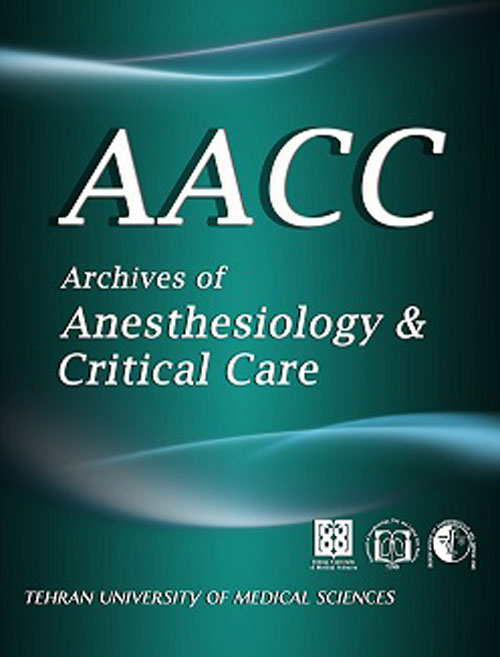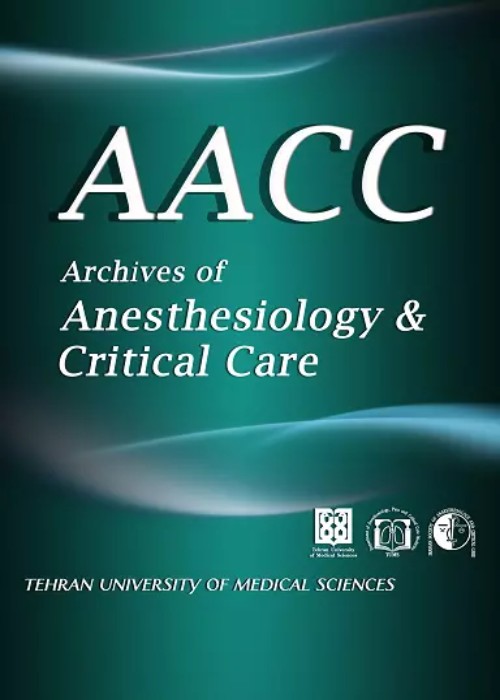فهرست مطالب

Archives of Anesthesiology and Critical Care
Volume:2 Issue: 2, Spring 2016
- تاریخ انتشار: 1395/03/25
- تعداد عناوین: 8
-
-
Page 174Constipation is a common complaint affecting a considerable part of the population in the western world [1]. Compared to men, women suffer more from this ailment [2]. Usually, more than one factor is involved. Lack of fiber in the diet, the presence of hemorrhoids or rectocele have all been incriminated to cause constipation or else exacerbate it. While bearing down causes some degree of perineal descent, reduced descent may indicate an inability of the pelvic floor muscles to relax during defecation. Excessive descent on the other hand can injure the sacral nerves and cause incontinence [3].
During defecation, there is some pressure exerted in the perianal region which causes pain, and the pain thus elicited prevents the normal process of defecation. Hard stools in itself cause pain and thus a vicious cycle is established preventing defecation and causing inspissation of stools. Under such conditions, a pressure exerted by the fore finger and middle finger on the perineum (Figure 1) directed towards the rectum not only acts as a support but exerts a pressure on the rectum and the anal canal and thus facilitates defecation. As hard stools and constipation impel and constrain the person to exert a high degree of straining during defecation and an effective straining effort can only be achieved if a high intra-abdominal pressure is built up, it is but natural that such an elevated intra-abdominal pressure can cause hemorrhoids and inguinal or epigastric hernias.
It has been said that perineal massage can increase the elasticity of the perineum and thus reduce the risk of third-degree perineal tears during labor [4].
We would emphasize that the two finger perineal pressure is helpful in relieving constipation and thus can prevent the formation of hemorrhoids. In a very small number of patients in a pilot study, we could find that the two finger perineal pressure had been extremely helpful in relieving constipation and helping in the evacuation of the stools. However, a randomized clinical trial is needed to further elucidate the effective role of the two finger perineal pressure in the evacuation of hard and inspissated stools. -
Pages 175-178BackgroundRemifentanil is a narcotic drug used in anaesthesia for establishment of hemodynamic stability. The purpose of this study was to compare the effects of remifentanil and fentanyl on urine excretion.MethodsIn a randomized clinical trial, 60 patients, who were candidates for elective surgery for lumbar posterior spinal fusion, were divided randomly into two groups of 30 as remifentanil propofol (R) and fentanyl- propofol (F). Maintenance of anaesthesia drugs in group R included 100 mcg/kg/min propofol and 0.5- 0.25 mcg/kg/min remifentanil. It included 100 mcg/kg/min propofol and 5- 0.5 mcg/kg/min fentanyl in group F. Vital signs and urine output were recorded every half an hour.ResultsThe mean age of patients was 49.5± 12.7 years. Urine output in group R showed significantly greater reduction than in group F (pConclusionUrine output in patients undergoing lumbar posterior spinal fusion who received remifentanil was less compared to the fentanyl group.Keywords: remifentanil, propofol, fentanyl, urine output, lumbar posterior spinal fusion
-
Pages 179-183BackgroundSulfur Mustard (SM) is an alkylating agent that has been used as a chemical warfare gas during World War II and by Iraqi army in the Iran-Iraq conflict between 1983 and 1988. SM can cause serious organ damages especially ocular, neurologic, coetaneous, bone marrow and pulmonary complications. On the other hand dexmedetomidine is a α2 agonist with sedative and analgesic effect with a short duration half-life. Considering these benefits, usage of dexmedetomidine would be a good choice in ophthalmic outpatients surgeries to keep the cognition state in an acceptable condition comparing with other available drugs especially in patients with concurrent chemical burn injury.MethodsAfter informed consent, patients with inclusion criteria were randomly divided in to two groups: dexmedetomidine (group D, n=50) and Remifentanil (group R, n=50). Cardiovascular signs, Mini Mental State Examination (MMSE) score were recorded as baseline. Patients received respectively dexmedetomidine by infusion with a loading dose of 0.5µg/kg (during 10 minutes) in group D. The maintenance dose of 0.2µg/kg/hr was then started. Loading dose of remifentanil was given by 0.1µg/kg (during 10 minutes); 5 minutes before local anesthesia in group R and maintenance dose of 0.05µg/kg/min was then started. In Post Anesthesia Care Unit (PACU) after 120 minutes of stopping drug infusions n-back and MMSE tests were performed.ResultsThe MMSE score had no statistically difference between two groups before surgery (in subgroup age>=65 P= 0.5, and in subgroup age=65 and age=65 PConclusionThe result of n-back and MMSE revealed that the cognition state improves better in patients receiving dexmedetomidine comparing with those of remifentanil. Dexmedetomidine is safe for protecting the cognition state especially in patients with borderline respiratory reserve due to chemical burn injury.Keywords: mustard gas, cognition state, n, back, Mini Mental State Examination
-
Pages 184-188BackgroundCataract extraction surgery remains the most commonly performed eye surgery by ophthalmologists. The maintenance of mydriasis is required throughout surgery to allow better visualization of the surgical field and a greater working space within the center of the eye. Non-steroidal anti-inflammatory agents (NSAIDs) have their effect in maintaining mydriasis by their ability to inhibit prostaglandin synthesis.MethodsThis was a prospective, randomized clinical trial study in 84 patients undergoing phacoemulsification cataract surgery. Patients were randomized to ketorolac tromethamine 0.5% (n=42) or the control group (n=42). Patients in the ketorolac group received one drop of ketorolac every 15 min for a total of 4 drops from one hour before surgery. The horizontal diameters of the pupil were measured in millimeters with a caliper under the microscope at the following stages: before surgery, after intracameral epinephrine injection, after nuclear emulsification and at the end of surgery.ResultsThe difference in pupillary diameter at the end of surgery was statistically significant between two groups (7.34 ± 1.0 mm and 8.01 ±0.67 mm in the control and the ketorolac groups, respectively; p=0.018). The difference in mean pupil size after intracameral epinephrine injection and after nuclear emulsification between the control group (0.51 ± 0.25 mm) and the ketorolac group (0.01 ± 0.20 mm) was statistically significant (pConclusionTopical ketorolac is an effective inhibitor of miosis during phacoemulsification cataract surgery, and provides a more stable mydriatic effect throughout the surgical procedure.Keywords: cataract surgery, ketorolac tromethamine, mydriasis, miosis, pupil diameter
-
Pages 189-192BackgroundSpinal anesthesia is usually applied for urologic surgeries. Postdural puncture headache (PDPH) is among common complications which has not been reduced during last years despite all advances in the field of medicine. Therapeutic effects of conventional therapy (paracetamol and novaphen) are being compared to intravenous meperidine in patients suffering from PDPH.MethodsOne hundred patients, with PDPH following spinal anesthesia for transurethral lithotripsy were enrolled and randomly allocated to receive conventional (group C) or intravenous meperidine (group P) (20 mg every 5min up to 120mg or when the pain was decreased to less than 3/10).ResultsTime interval to reach acceptable headache was 3 hours in group P compared to 8 hours in group C. Group P patients received statistically significantly less amount of paracetamol and novaphen, and experienced fewer episodes of severe headaches in 48 hours after the start of treatment, compared to group C.ConclusionShort term intravenous meperidine compared to conventional therapy resulted in more rapid and effective outcomes.Keywords: meperidine, acetaminophen, post, dural puncture headache
-
Pages 193-196BackgroundNosocomial pneumonia is a prevalent complication in patients admitted to intensive care units (ICU). Endotracheal suction is used in cleaning the airways of secretions in patients under mechanical ventilation. Performing suction accurately is of great importance to prevent ventilation associated pneumonia. The purpose of this study was to compare the effect of open versus closed tracheal suction on the incidence of VAP.MethodsThis was a clinical trial study performed on 86 intubated patients in ICU. Patients of control group (n=43) underwent conventional open suction and case group (n=43) closed suction. After 72 hours, patients were assessed regarding VAP using clinical pulmonary infection score (CPIS).ResultsThere was no significant difference regarding age (p=0.15) and gender (p=0.33) between the two groups. The incidence of ventilator associated pneumonia was significantly lower in closed method compared to the open method (p=0.016).ConclusionClosed tracheal suction compared to the open method was associated with lower incidence of VAP in patients of ICU.Keywords: ventilation associated pneumonia, intensive care unit, nosocomial pneumonia
-
The Use of Lidocaine and Prilocaine in Dental Surgery. A ReviewPages 197-199The purpose of the present article is to carry out a review of the literature on two local anesthetic agents, which are the most commonly used drugs in dental procedures. It would provide a clear concept about the local anesthetics, their dosages and exact usage in dental surgeries.Keywords: local anesthetics, lidocaine, prilocaine, dental surgery
-
Pages 200-202Mucormycosis is a serious fungal infection caused by the filamentous fungi of the mucorales order of the class of zygomycetes. Mucormycosis is classically defined as an opportunistic fatal infection. In this report we explain a 49 years old woman with palato-orbital tract as a sequel of rhino cerebral mucormycosis and end stage renal disease candidate for kidney transplantation. Difficulties in airway management as well as inducing and maintaining anesthesia was our main concern.Keywords: mucormycosis, kidney transplantation, airway management


